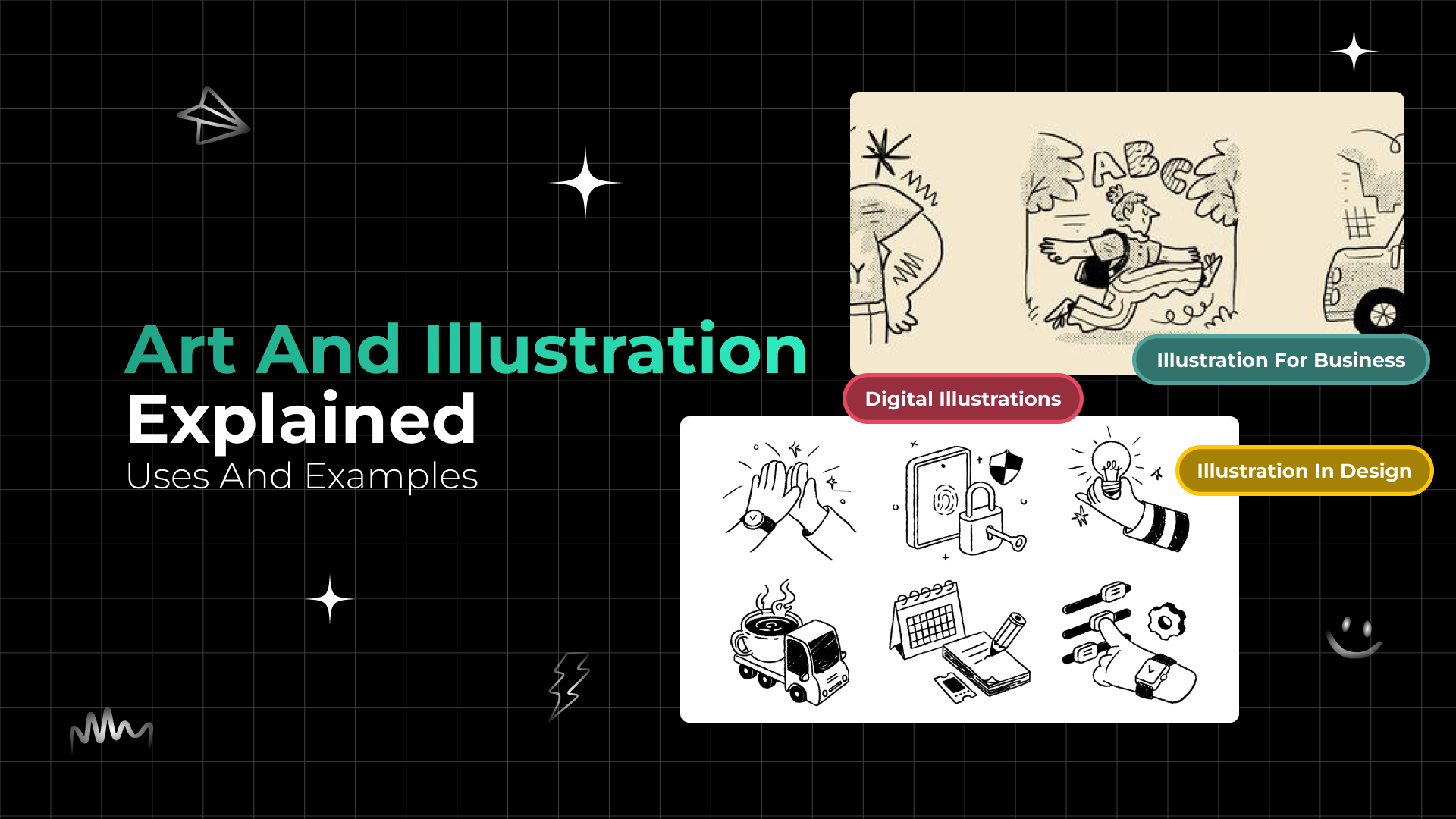Art and Illustration Explained : Uses and Examples

Art and illustration have been an integral part of human expression for centuries, shaping how we communicate ideas visually.
Long before written language, early humans used cave paintings and symbols to tell stories, document events, and share knowledge. From ancient Egyptian hieroglyphs to medieval manuscripts adorned with intricate illustrations, visual storytelling has played a vital role in preserving history and conveying messages across generations.
But what exactly is illustration, and how is it different from other forms of art?
In this blog, we’ll explore the meaning of illustration, its various uses in industries like advertising and publishing, and some well-known examples.
So, if you’re an artist, a designer, or just curious, this guide will help you understand the role of illustration in everyday life.
What Are Illustrations?
Illustrations are visual representations created to explain, enhance, or complement a concept, story, or piece of information.
Unlike fine art, which is often created for aesthetic purposes, illustrations serve a functional role in communication.
They can be hand-drawn or digital and are widely used in books, advertisements, websites, and educational materials to make content more engaging and easier to understand.
Examples of Illustrations
Illustrations are used in various fields to simplify information, enhance storytelling, and create engaging visuals.
From books and advertisements to educational materials and branding, illustrations help convey messages effectively.
Illustrations can be hand-drawn or digital, illustrations add creativity and clarity, making complex ideas easier to understand.
Below are some common types of illustrations along with examples:
- Editorial Illustrations – Found in magazines and newspapers to visually support articles (The Hindu or India Today).
- Children’s Book Illustrations – Used to bring stories to life with vibrant imagery (e.g.,Mathee interactive books by doodlo design studio).
- Advertising Illustrations – Help brands create unique and eye-catching marketing visuals (e.g., Coca-Cola’s vintage illustrated posters).
- Technical Illustrations – Explain complex concepts in manuals, textbooks, and guides (e.g., diagrams in engineering books).
- Medical Illustrations – Used in healthcare to depict anatomy and procedures for educational purposes (e.g., human body diagrams in medical textbooks).
- Concept Art – Created for movies, video games, and animations to visualize characters and scenes (e.g., character sketches for Disney films).
Why Should Businesses Use Illustrations?
Illustrations are a powerful tool for businesses to communicate their message in a visually appealing and engaging way.
Unlike stock photos, custom illustrations can be personalized to match a brand’s identity, making content more unique and memorable.
They help simplify complex ideas, making it easier for customers to understand products or services. Businesses also use illustrations to enhance branding, create eye-catching advertisements, and improve user experience on websites and apps.
Whether in marketing, packaging, or social media, illustrations help brands stand out and connect with their audience effectively.
Types of Illustrations and Their Uses
Illustrations come in various styles, each serving a unique purpose in different industries. Whether used for storytelling, branding, education, or marketing, illustrations enhance communication and engagement. Each type of illustration serves a distinct function, helping industries communicate effectively and visually engage their audience.
Here are some common types of illustrations and their applications:
- Hand-Drawn Illustrations – Traditional sketches or paintings used in books, comics, and fine art (e.g., watercolor illustrations in children’s storybooks).
- Digital Illustrations – Created using software like Adobe Illustrator or Procreate for websites, advertising, and social media (e.g., brand mascots and web graphics).
- Vector Illustrations – Scalable, clean-line graphics often used in branding, infographics, and UI/UX design (e.g., app icons and infographic visuals).
- 3D Illustrations – Three-dimensional artworks used in gaming, animation, and medical visualization (e.g., 3D product mockups in advertising).
- Technical Illustrations – Precise and detailed drawings used in engineering, architecture, and instruction manuals (e.g., exploded-view diagrams in mechanical guides).
- Medical Illustrations – Detailed visuals used in healthcare education and research (e.g., anatomy diagrams in medical textbooks).
- Fashion Illustrations – Artistic sketches used in the fashion industry for designing and showcasing apparel (e.g., runway collection previews).
- Storyboard Illustrations – Sequential drawings used in filmmaking, animation, and advertising to plan visual narratives (e.g., movie scene sketches).
The Role of Illustrations in Digital Media
Illustrations play an essential role in digital media by making content more engaging, visually appealing, and easier to understand.
They help brands create unique identities, enhance user experience, and communicate complex ideas effectively. Whether used in websites, mobile apps, or social media, illustrations provide a creative edge that photography alone cannot achieve.
Let’s look at some examples where illustrations are widely used in digital media:
- Website Design – Custom illustrations enhance website aesthetics, improve navigation, and strengthen brand identity (e.g., hero section illustrations on landing pages).
- Mobile Apps – Used in UI/UX design to create intuitive interfaces, onboarding screens, and engaging interactions (e.g., illustrated walkthrough guides in fintech apps).
- Social Media Graphics – Brands use illustrations for unique, shareable content in marketing campaigns and storytelling (e.g., Instagram carousel posts with hand-drawn elements).
- Infographics – Illustrated infographics simplify complex data and make information visually digestible (e.g., infographic reports on sustainability).
- Explainer Videos – Animated illustrations help break down concepts in educational and promotional videos (e.g., motion graphics for SaaS product demos).
- Digital Advertising – Businesses use eye-catching illustrations in online ads, banners, and email marketing to attract attention (e.g., illustrated ads for e-commerce sales).
- E-Learning & Educational Content – Illustrations enhance online courses, making learning more interactive and visually engaging (e.g., illustrated diagrams in coding tutorials).
Bringing Ideas to Life with Illustrations with Doodlo Design Studio
Doodlo Design Studio specializes in creating unique and visually compelling illustrations custom-made for businesses, brands, and digital media.
From custom branding elements to engaging website graphics, we bring creativity and precision to every project. Whether you need digital illustrations, marketing visuals, or UI/UX assets, we’ve got you covered.
Ready to elevate your brand with stunning illustrations? Contact us today!